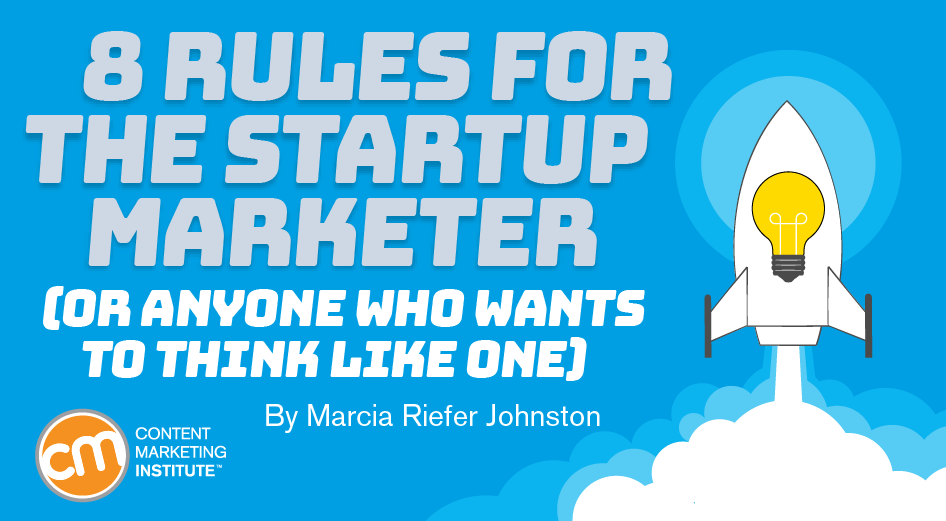Author: Marcia Riefer Johnston / Source: Content Marketing Institute

If you work in a big, established company, a presentation on being a marketer on a small team, especially a small team in a startup, may not seem to apply to you. But the wisdom 2015 Content Marketer of the Year Vishal Khanna has to share extends to anyone who wants the flexibility and performance possible when you act like a startup marketer.
For most of his 15-plus years in marketing, Vishal has been his organization’s only resource for marketing, communications, and media relations. “Everywhere I’ve worked, I’ve had a low budget, no staff, no resources, and limited access. In that situation, you’ve got to be creative,” he says.
Whether or not you think of your company as a startup, put on your startup-marketer hat, and consider which pieces of Vishal’s advice might make all the difference for you.
Unless otherwise noted, all images and quotations in this post come from Vishal’s Intelligent Content Conference talk How to Connect Your Content and Technology to Your Business Goals with a Small Team (which he told his audience he almost titled “Straight Outta Locash”).
1. Build a simple system that frees you to do extraordinary work
“Be regular and orderly in your life … so that you may be violent and original in your work.” Quoting Flaubert is Vishal’s way of telling marketers, build a simple system that frees you to do extraordinary work.
The kind of system he’s talking about is the process that supports what your marketing and sales teams want to accomplish. Without endorsing any particular tools or approaches, he gives a couple of examples of what this type of system might look like from his experience.
Here’s one:

This example comes from a situation in which a market researcher checked LinkedIn’s Sales Navigator and qualified all the leads that came in to a medical research organization Vishal was working for, answering questions like these: Who are they? What are their characteristics? What companies do they come from? What are their interests? What drugs are they developing?
The team used MailChimp to first communicate with leads via email. When people opted in to a certain level, the marketing team put their data in Pardot, which initiated automation programs. “When they were nurtured enough,” Vishal says, “we’d shoot them over to Salesforce, where our sales team would take over and aim for the goal, which was of course a big pot of money at the end.”
Here’s another example:

This system includes the following tools:
- Hunter, an email verifier into which you can toss an email address to find out if it’s a valid address (Such verifiers are limited in their reliability, he points out.)
- Winmo, a database that includes many contacts in the pharmaceutical industry as well as a lot of market research (“I didn’t have the resources to hire someone to do this research. I had to find tools that can mimic that as well as possible,” Vishal says.)
- SharpSpring, an automation program at the heart of the system (“I’m not advocating for them. You put your automation program in the center. Make sure every single thing around that is integrated,” Vishal says.)
- AdButler, which runs the display ads
- Unbounce, which has his landing page
- Salesforce, into which all of these integrated tools push leads. (“When we push a lead over to Salesforce, everything that lead ever did has to transfer over,” Vishal says.)
Whatever tools you choose, make sure that they work together. As Vishal says:
Find an automation program that matches with your sales platform. Make sure that data follows over. If you don’t, every time you push a lead over to Salesforce, you’re going to have to send an email saying, ‘Hey Greg, this person downloaded our white paper and then went to these three pages.’ Your system has to get that intelligence to your salespeople automatically so that they know what to do without anyone having to send that email.
Vishal’s observations line up with the Content Marketing Institute’s latest research, which Lisa Murton Beets recently summarized (bolding is mine):
Eighty-eight percent of top performers value creativity and craft in content creation and production, compared with 74% of all respondents. In addition, 70% of top performers rate project management flow of their content-creation projects as ‘excellent’ or ‘very good’ versus only 36% of all respondents. As you can see, most respondents value creativity and craft. Where successful content marketers seem to have an edge is that they have good processes.
No one process or system is ideal for every situation. Find the right tools and the right flow to manage your lead-nurturing process in relation to your content engagement. Develop separate processes as needed to cover distinct categories of leads; for example, Vishal used categories like digital marketers, life-sciences consultants, pharma directors, agency leaders, innovations directors, and brand managers.
But don’t overcomplicate things. “Make it a simple system that you can manage – and then be extraordinary in the content you develop and push out there and the strategies you implement,” Vishal says.
2. Be passionate about your work
No system in the world can make up for a lack of passion for what you’re doing with it. Passion is critical to the success of any startup (or any business). That may seem to go without saying, but the reminder is worth repeating to keep our focus where it belongs: on making a difference for the people we create our content for. As Vishal explains:
You have to be passionate about what you do. I probably think about what I do half of the time I’m not working. I’m constantly trying to figure out how to make things work better. I take personally what I do. If I didn’t believe in my brand, I wouldn’t be able to do what I’ve done.
While people working in startups often have the extra motivator of having “a chunk of ownership” of the…
Audience Team
The digital audience insights you need to build, manage and market to your digital audiences.

